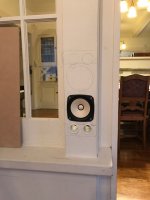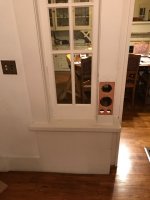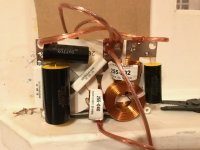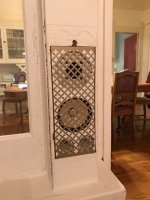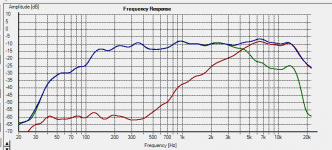I thought it worth documenting what I'm currently working on.
It all started because my beloved decided the HiFi needed to move from a compromised position in one room to an impossible position in another. I'll post a photo, but suffice it to say that if I want speakers in the right position for critical listening, they can't take up any floor space. I toyed with the idea of buying a Bose Acoustimass or similar tiny satellite system, but I knew I would never be happy with it.
It was then that I hit on the idea of building speakers into the wall. What's great about the situation is that by "wall", I don't mean drywall, I mean 3/4" thick wood pillars that would potentially make great speakers - particularly when combined with a sub. It seemed genius: I get to build my own speakers and it would be the ultimate WAF in that you simply wouldn't see them.
Having decided that this would be a good idea, I considered the constraints.
Baffle is a fixed size of 14cm (5.5") wide and about 1.5m (5') tall. That means I would need 4" drivers. So OK - where to begin?
It's fair to say that I've learned a lot so far. I read - and internalized - the advice about building proven designs. Problem is, my enclosure is what it is and there'll be no existing project that matches the characteristics. So I need to learn and adapt.
This thread will be a catalogue of my progress
It all started because my beloved decided the HiFi needed to move from a compromised position in one room to an impossible position in another. I'll post a photo, but suffice it to say that if I want speakers in the right position for critical listening, they can't take up any floor space. I toyed with the idea of buying a Bose Acoustimass or similar tiny satellite system, but I knew I would never be happy with it.
It was then that I hit on the idea of building speakers into the wall. What's great about the situation is that by "wall", I don't mean drywall, I mean 3/4" thick wood pillars that would potentially make great speakers - particularly when combined with a sub. It seemed genius: I get to build my own speakers and it would be the ultimate WAF in that you simply wouldn't see them.
Having decided that this would be a good idea, I considered the constraints.
Baffle is a fixed size of 14cm (5.5") wide and about 1.5m (5') tall. That means I would need 4" drivers. So OK - where to begin?
It's fair to say that I've learned a lot so far. I read - and internalized - the advice about building proven designs. Problem is, my enclosure is what it is and there'll be no existing project that matches the characteristics. So I need to learn and adapt.
This thread will be a catalogue of my progress
Approach 1
First thing I did was to buy a commercial speaker that uses a 4" driver. I figured that I could reuse the drivers and crossover and just relocate them into the wall! So I bought the Pioneer SP-BS22-LR from Amazon, broke them in and wanted to see whether I could live with them.
Problem was, I just couldn't get excited about the sound. My goto speakers (that I've had for 20 years) are Rogers LS2/a2 which have such a revealing midrange that I find missing from most modern bookshelf speakers I listen to.
So I shelved the idea of the Pioneers and decided to go the DIY route.
Approach 2
I read a ton about DIY speaker design. Looked a lot at Paul Carmody's pages. I experimented with measuring response using HolmImpulse and I went out and bought a couple Dayton RS100-4 4" drivers and RS28A-4 tweeters. My beloved Rogers use aluminum tweeters and they seemed like a good option.
At the same time I started playing around with crossover design programs and enclosure modeling and ended up with a crossover design based off of Paul Carmody's Core 2-way (https://sites.google.com/site/undefinition/core-2-way) that I tried out with the speakers.
I did a ton of experiments with these drivers: Full-range single driver, full-range 2 driver, 2-way MTM with the crossover. Nothing I tried sounded all that great. However, I learned a ton about the process as I went.
The main things I learned are that (1) The RS100-4 is inefficient and not really credible as a full-range driver. (2) My crossover design needed iterating. (3) I hadn't yet got a handle on enclosure design.
Regardless, I decided that the RS100-4 wasn't what I wanted from a bass/midrange.
First thing I did was to buy a commercial speaker that uses a 4" driver. I figured that I could reuse the drivers and crossover and just relocate them into the wall! So I bought the Pioneer SP-BS22-LR from Amazon, broke them in and wanted to see whether I could live with them.
Problem was, I just couldn't get excited about the sound. My goto speakers (that I've had for 20 years) are Rogers LS2/a2 which have such a revealing midrange that I find missing from most modern bookshelf speakers I listen to.
So I shelved the idea of the Pioneers and decided to go the DIY route.
Approach 2
I read a ton about DIY speaker design. Looked a lot at Paul Carmody's pages. I experimented with measuring response using HolmImpulse and I went out and bought a couple Dayton RS100-4 4" drivers and RS28A-4 tweeters. My beloved Rogers use aluminum tweeters and they seemed like a good option.
At the same time I started playing around with crossover design programs and enclosure modeling and ended up with a crossover design based off of Paul Carmody's Core 2-way (https://sites.google.com/site/undefinition/core-2-way) that I tried out with the speakers.
I did a ton of experiments with these drivers: Full-range single driver, full-range 2 driver, 2-way MTM with the crossover. Nothing I tried sounded all that great. However, I learned a ton about the process as I went.
The main things I learned are that (1) The RS100-4 is inefficient and not really credible as a full-range driver. (2) My crossover design needed iterating. (3) I hadn't yet got a handle on enclosure design.
Regardless, I decided that the RS100-4 wasn't what I wanted from a bass/midrange.
Approach 3
At this point, I got interested in the idea of full-range drivers. More in the sense of having minimal visual impact as much as the purity of sound.
It seemed like the 4" driver requirement put me squarely in the realm of folks who were building all sorts of curious enclosures like the Frugel-Horn.
I decided I'd see how good these kind of drivers could be. So I bought a Fostex FE126En and a Mark Audio Pluvia 7. I would have tried the Alpair 7.3, but it's too big for the baffle.
I tried both these drivers in various types of cabinets after putting 20-30 hours on them and found them to have very interesting characteristics.
The Fostex seems to divide opinion and I can see why. It has a beguilingly open character and a wonderful soundstage - kind of exactly what I'm looking for - but gets quacky and honky in the upper-mids. Response over 10k is actually pretty decent, but while the upper midrange works well with some female vocals, it's distractingly unbalanced with certain tracks.
The Pluvia is remarkable in how it's able to coax genuine lows and genuine highs from a single small driver and is much easier on the ears. If anything it's a little bit bright and "sweet" sounding, but it's going to be my single-driver solution to feed the dining room, no question.
At this point, I got interested in the idea of full-range drivers. More in the sense of having minimal visual impact as much as the purity of sound.
It seemed like the 4" driver requirement put me squarely in the realm of folks who were building all sorts of curious enclosures like the Frugel-Horn.
I decided I'd see how good these kind of drivers could be. So I bought a Fostex FE126En and a Mark Audio Pluvia 7. I would have tried the Alpair 7.3, but it's too big for the baffle.
I tried both these drivers in various types of cabinets after putting 20-30 hours on them and found them to have very interesting characteristics.
The Fostex seems to divide opinion and I can see why. It has a beguilingly open character and a wonderful soundstage - kind of exactly what I'm looking for - but gets quacky and honky in the upper-mids. Response over 10k is actually pretty decent, but while the upper midrange works well with some female vocals, it's distractingly unbalanced with certain tracks.
The Pluvia is remarkable in how it's able to coax genuine lows and genuine highs from a single small driver and is much easier on the ears. If anything it's a little bit bright and "sweet" sounding, but it's going to be my single-driver solution to feed the dining room, no question.
Last edited:
Approach 4
Knowing that I was experiencing something magical with the Fostex, but realising that I was going to have to work harder to get anything close to flat below 300hz and knowing that I couldn't live with it as a full-range driver, I decided to try pairing it up with the RS28A-4s I'd bought.
I have an active crossover and I was able to experiment with biamping and seeing whether they might play well together. I was very happy with the results! Crossing over as low as 1400hz, it feels like you retain some of the openness and soundstage of the Fostex but with a much more controlled upper register.
The Sub
So far, I haven't mentioned the Sub. I bought a Dayton RSS265HF-4, mostly because of the reviews and also because every bass player I've ever worked with sounded best out of a 2x10 cab. Did I actually consider the constraints of the space? Nah.
So I can get up to 40L (1.4 ft3) out of the space I have, but it will be a thin build - so thin in fact that the magnet will be almost touching the back panel of the enclosure.
Weighing up the benefits of bass reflex vs sealed, I pretty much decided on sealed, since I don't need thunderous explosions, I just want good deep tight musical bass. Additionally, the constraints of the space mean that an optimum bass reflex enclosure is bigger than I have space for.
So I built an enclosure of the optimum size recommended on the Parts Express page (0.5 ft3) and it kind of sucked. It just doesn't sound right. It produces a hump around 60hz which is a little unpleasant. I've since modeled it in WinISD, which shows the hump a little higher, but it's still there regardless.
Next I'll try one at 35L.
Knowing that I was experiencing something magical with the Fostex, but realising that I was going to have to work harder to get anything close to flat below 300hz and knowing that I couldn't live with it as a full-range driver, I decided to try pairing it up with the RS28A-4s I'd bought.
I have an active crossover and I was able to experiment with biamping and seeing whether they might play well together. I was very happy with the results! Crossing over as low as 1400hz, it feels like you retain some of the openness and soundstage of the Fostex but with a much more controlled upper register.
The Sub
So far, I haven't mentioned the Sub. I bought a Dayton RSS265HF-4, mostly because of the reviews and also because every bass player I've ever worked with sounded best out of a 2x10 cab. Did I actually consider the constraints of the space? Nah.
So I can get up to 40L (1.4 ft3) out of the space I have, but it will be a thin build - so thin in fact that the magnet will be almost touching the back panel of the enclosure.
Weighing up the benefits of bass reflex vs sealed, I pretty much decided on sealed, since I don't need thunderous explosions, I just want good deep tight musical bass. Additionally, the constraints of the space mean that an optimum bass reflex enclosure is bigger than I have space for.
So I built an enclosure of the optimum size recommended on the Parts Express page (0.5 ft3) and it kind of sucked. It just doesn't sound right. It produces a hump around 60hz which is a little unpleasant. I've since modeled it in WinISD, which shows the hump a little higher, but it's still there regardless.
Next I'll try one at 35L.
Last edited:
This brings us up to date. Next steps are:
1) Drill holes / route the wall and decide on grille material.
2) Mount the Fostex drivers & tweeters with the grilles (necessary to stop toddler interference)
3) Repeat the experiments with the active crossover with the drivers and grilles in place
4) Design a passive crossover that will closely match the configuration of the active one I'm using
5) Iterate over the passive crossover till it sounds right
6) Introduce the sub into the equation
7) Mount the Pluvias into the opposite side of the wall
8) Stand back and enjoy.
1) Drill holes / route the wall and decide on grille material.
2) Mount the Fostex drivers & tweeters with the grilles (necessary to stop toddler interference)
3) Repeat the experiments with the active crossover with the drivers and grilles in place
4) Design a passive crossover that will closely match the configuration of the active one I'm using
5) Iterate over the passive crossover till it sounds right
6) Introduce the sub into the equation
7) Mount the Pluvias into the opposite side of the wall
8) Stand back and enjoy.
First hole cut in the pillar! I opted to keep it in place, rather than replace it and have to redecorate.
http://www.diyaudio.com/forums/attachment.php?attachmentid=599296&stc=1&d=1487098525
Testing bass reflex port size for the enclosure. Used 2x 1.5 inch 9cm ports in a 5.5L enclosure. Tuned for around 100hz. Works well!
http://www.diyaudio.com/forums/attachment.php?attachmentid=599297&stc=1&d=1487098525
Choice between removing the baffle, cutting a hole and mounting a recessed baffle behind, or just routing out the baffle in place. Chose the latter. A little messy, but will clean up just fine.
http://www.diyaudio.com/forums/attachment.php?attachmentid=599298&stc=1&d=1487098525
http://www.diyaudio.com/forums/attachment.php?attachmentid=599296&stc=1&d=1487098525
Testing bass reflex port size for the enclosure. Used 2x 1.5 inch 9cm ports in a 5.5L enclosure. Tuned for around 100hz. Works well!
http://www.diyaudio.com/forums/attachment.php?attachmentid=599297&stc=1&d=1487098525
Choice between removing the baffle, cutting a hole and mounting a recessed baffle behind, or just routing out the baffle in place. Chose the latter. A little messy, but will clean up just fine.
http://www.diyaudio.com/forums/attachment.php?attachmentid=599298&stc=1&d=1487098525
Attachments
For what it's worth, I did some measurements on a FE126eN (FE126E, treated by Planet10) here: http://www.diyaudio.com/forums/full...26en-small-google-page-ranking-enclosure.html
There's a tilted-up response, spike at 6.6kHz, and very little bass extension. The result is a "fast", "snappy" sort of sound that I quickly get tired of. I'd recommend EQ with these drivers if neutrality is a concern.
Chris
There's a tilted-up response, spike at 6.6kHz, and very little bass extension. The result is a "fast", "snappy" sort of sound that I quickly get tired of. I'd recommend EQ with these drivers if neutrality is a concern.
Chris
I hear you Chris. Really interesting write-up you linked to - thanks for sharing!
As I mention above, there's something captivating about the sound from the Fostex, but I would totally agree about the peak at 7k and the limited bass. I'm actually very pleased at how much bass I get from the double-ported setup I have in the pictures, at least compared to the test cabinets I tried prior to that.
However, this is why I'm going to be running 2-way with a sub. I actually preferred the sound of the Fostex crossed below 2khz and I feel that they're still able to impart some character crossed that low.
As I mention above, there's something captivating about the sound from the Fostex, but I would totally agree about the peak at 7k and the limited bass. I'm actually very pleased at how much bass I get from the double-ported setup I have in the pictures, at least compared to the test cabinets I tried prior to that.
However, this is why I'm going to be running 2-way with a sub. I actually preferred the sound of the Fostex crossed below 2khz and I feel that they're still able to impart some character crossed that low.
Made great progress today. Managed to finish my routing, get the tweeter in, do hours of listening and tweaking and then design a passive crossover to match my active crossover settings.
Response Modeler suggested I'd have a hump of +2db between 1 and 2k and this was exactly what I saw.
http://www.diyaudio.com/forums/attachment.php?attachmentid=600371&stc=1&d=1487571146
This was my measured result with the active crossover (what I'm aiming for). This is with a -2db equalization applied at 1k - 2k. It may seem like it should have more, but this sounded about right. Note that I crossed it higher than I originally intended - now about 2.8k. The nice thing about the active crossover is it allows for a lot of experimentation.
Note the dip at 500hz. Adding EQ didn't sound right and I know these kind of measurements aren't necessarily reliable in the room, so left it as is.
http://www.diyaudio.com/forums/attachment.php?attachmentid=600372&stc=1&d=1487571318
This is the graph I got from WinPCD crossover designer. I used the measured Woofer FRD, modeled ZMA (exported from Response Modeler) and the factory tweeter FRD and ZMA files. It's about as close as I'll come for now. I can tweak it later.
http://www.diyaudio.com/forums/attachment.php?attachmentid=600373&stc=1&d=1487571702
Here's the schematics:
http://www.diyaudio.com/forums/attachment.php?attachmentid=600374&stc=1&d=1487571802
http://www.diyaudio.com/forums/attachment.php?attachmentid=600375&stc=1&d=1487571802
I used an RLC notch filter for the 1k hump and a zobel network for steeper roll-off. Also the 5ohm resister in the tweeter circuit was just to get the factory FRD values to match up with the measured one for the woofer. I won't actually use that.
It'll be interesting to see how it comes together! It really sounds good with the sub.
Response Modeler suggested I'd have a hump of +2db between 1 and 2k and this was exactly what I saw.
http://www.diyaudio.com/forums/attachment.php?attachmentid=600371&stc=1&d=1487571146
This was my measured result with the active crossover (what I'm aiming for). This is with a -2db equalization applied at 1k - 2k. It may seem like it should have more, but this sounded about right. Note that I crossed it higher than I originally intended - now about 2.8k. The nice thing about the active crossover is it allows for a lot of experimentation.
Note the dip at 500hz. Adding EQ didn't sound right and I know these kind of measurements aren't necessarily reliable in the room, so left it as is.
http://www.diyaudio.com/forums/attachment.php?attachmentid=600372&stc=1&d=1487571318
This is the graph I got from WinPCD crossover designer. I used the measured Woofer FRD, modeled ZMA (exported from Response Modeler) and the factory tweeter FRD and ZMA files. It's about as close as I'll come for now. I can tweak it later.
http://www.diyaudio.com/forums/attachment.php?attachmentid=600373&stc=1&d=1487571702
Here's the schematics:
http://www.diyaudio.com/forums/attachment.php?attachmentid=600374&stc=1&d=1487571802
http://www.diyaudio.com/forums/attachment.php?attachmentid=600375&stc=1&d=1487571802
I used an RLC notch filter for the 1k hump and a zobel network for steeper roll-off. Also the 5ohm resister in the tweeter circuit was just to get the factory FRD values to match up with the measured one for the woofer. I won't actually use that.
It'll be interesting to see how it comes together! It really sounds good with the sub.
Attachments
-
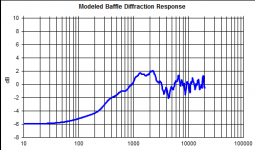 Screen Shot 2017-02-19 at 10.11.19 PM.png20.6 KB · Views: 307
Screen Shot 2017-02-19 at 10.11.19 PM.png20.6 KB · Views: 307 -
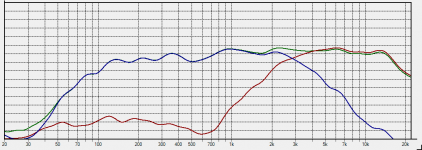 Screen Shot 2017-02-19 at 10.14.16 PM.png33 KB · Views: 278
Screen Shot 2017-02-19 at 10.14.16 PM.png33 KB · Views: 278 -
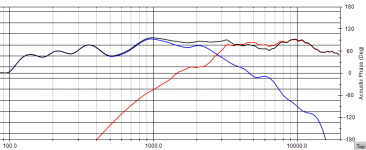 Screen Shot 2017-02-19 at 10.19.19 PM.png40.9 KB · Views: 161
Screen Shot 2017-02-19 at 10.19.19 PM.png40.9 KB · Views: 161 -
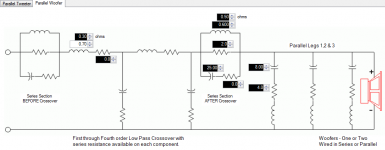 Screen Shot 2017-02-19 at 10.22.45 PM.png54.4 KB · Views: 147
Screen Shot 2017-02-19 at 10.22.45 PM.png54.4 KB · Views: 147 -
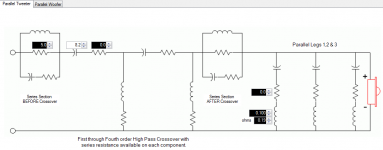 Screen Shot 2017-02-19 at 10.22.33 PM.png49.2 KB · Views: 178
Screen Shot 2017-02-19 at 10.22.33 PM.png49.2 KB · Views: 178
Last edited:
Well... massive development today!
Passive crossover components arrived yesterday expedited from Parts Express and I managed to find time this evening to put it together and measure it.
http://www.diyaudio.com/forums/attachment.php?attachmentid=601172&stc=1&d=1487918642
To say I'm pleased with the result would be an understatement. It wasn't *quite* what I was intending in terms of the crossover point which is now actually around 4k. But I seem to have fluked it somehow because the overall curve measures pretty flat. The notch filter is working perfectly at keeping it relatively flat around 1 - 2khz. It looks like it might have a slight hump around 7k (somewhat ironic given it's a characteristic of the Fostex I was trying to eliminate), but it's not noticeable.
http://www.diyaudio.com/forums/attachment.php?attachmentid=601174&stc=1&d=1487918642
Still needs painting, but here is the current state of the woodwork and grille
http://www.diyaudio.com/forums/attachment.php?attachmentid=601173&stc=1&d=1487918642
Passive crossover components arrived yesterday expedited from Parts Express and I managed to find time this evening to put it together and measure it.
http://www.diyaudio.com/forums/attachment.php?attachmentid=601172&stc=1&d=1487918642
To say I'm pleased with the result would be an understatement. It wasn't *quite* what I was intending in terms of the crossover point which is now actually around 4k. But I seem to have fluked it somehow because the overall curve measures pretty flat. The notch filter is working perfectly at keeping it relatively flat around 1 - 2khz. It looks like it might have a slight hump around 7k (somewhat ironic given it's a characteristic of the Fostex I was trying to eliminate), but it's not noticeable.
http://www.diyaudio.com/forums/attachment.php?attachmentid=601174&stc=1&d=1487918642
Still needs painting, but here is the current state of the woodwork and grille
http://www.diyaudio.com/forums/attachment.php?attachmentid=601173&stc=1&d=1487918642
Attachments
Last edited:
Cool!
Careful of putting inductors close together. They can act like transformers and do all sorts of interesting things.
Chris
Careful of putting inductors close together. They can act like transformers and do all sorts of interesting things.
Chris
Had some time to tweak this evening.
Started by trying a lower crossover point by substituting the 0.7mH / 8uF combo for a 1.5mH / 15uF combo with a 1ohm resister on the parallel tweeter inductor.
The result produced a pretty flat response and a crossover point at 2.8khz, but I didn't like the sound of it as much. I felt like the openness of the Fostex was stifled a little.
So I decided to leave the woofer as is and play with the tweeter setup a little. My baseline was my original design of 0.7mH / 8uF which for reference is here:
http://www.diyaudio.com/forums/attachment.php?attachmentid=601314&stc=1&d=1487997860
I then tried 3 different tweeter settings shown here. Blue is 15uF with the 1ohm resistor on the parallel inductor. Red is the 8uF with the 1 ohm resistor. Green is 8uF without the resistor.
http://www.diyaudio.com/forums/attachment.php?attachmentid=601313&stc=1&d=1487997860
This gave me the following 3 curves:
http://www.diyaudio.com/forums/attachment.php?attachmentid=601312&stc=1&d=1487997860
The latter baseline is the flattest overall and even has a little boost up in the 10k+ range, which is good because that gets a little damped with the grille in place.
What's was really interesting was to compare the baseline to the LS2a/2 that's being resigned to storage. Blue is the Rogers. Red is what I've made. Pretty close I'd say.
http://www.diyaudio.com/forums/attachment.php?attachmentid=601311&stc=1&d=1487997860
Started by trying a lower crossover point by substituting the 0.7mH / 8uF combo for a 1.5mH / 15uF combo with a 1ohm resister on the parallel tweeter inductor.
The result produced a pretty flat response and a crossover point at 2.8khz, but I didn't like the sound of it as much. I felt like the openness of the Fostex was stifled a little.
So I decided to leave the woofer as is and play with the tweeter setup a little. My baseline was my original design of 0.7mH / 8uF which for reference is here:
http://www.diyaudio.com/forums/attachment.php?attachmentid=601314&stc=1&d=1487997860
I then tried 3 different tweeter settings shown here. Blue is 15uF with the 1ohm resistor on the parallel inductor. Red is the 8uF with the 1 ohm resistor. Green is 8uF without the resistor.
http://www.diyaudio.com/forums/attachment.php?attachmentid=601313&stc=1&d=1487997860
This gave me the following 3 curves:
http://www.diyaudio.com/forums/attachment.php?attachmentid=601312&stc=1&d=1487997860
The latter baseline is the flattest overall and even has a little boost up in the 10k+ range, which is good because that gets a little damped with the grille in place.
What's was really interesting was to compare the baseline to the LS2a/2 that's being resigned to storage. Blue is the Rogers. Red is what I've made. Pretty close I'd say.
http://www.diyaudio.com/forums/attachment.php?attachmentid=601311&stc=1&d=1487997860
Attachments
Last edited:
Cool!
Careful of putting inductors close together. They can act like transformers and do all sorts of interesting things.
Chris
Yea good warning Chris. I was careful to put them at different 3D planes to each other. It would probably be optimal to have them a little further apart, but I'm no expert. I suspect the crosstalk is minimal if the fields they're producing are on different planes.
Found this, which would suggest that it might be better to have them a little further apart despite the orientation: http://www.troelsgravesen.dk/coils.htm
Last edited:
- Status
- Not open for further replies.
- Home
- Loudspeakers
- Multi-Way
- Fostex FE126En two-way wall install build thread

